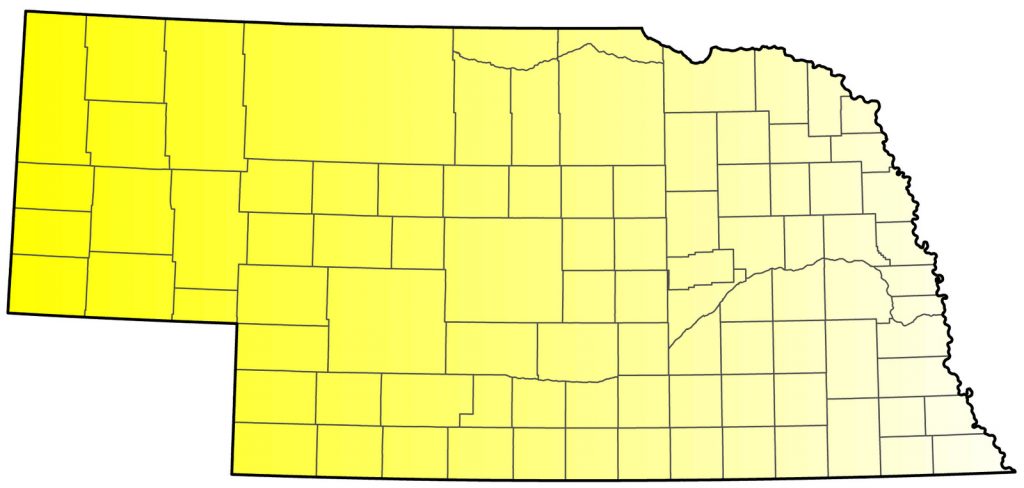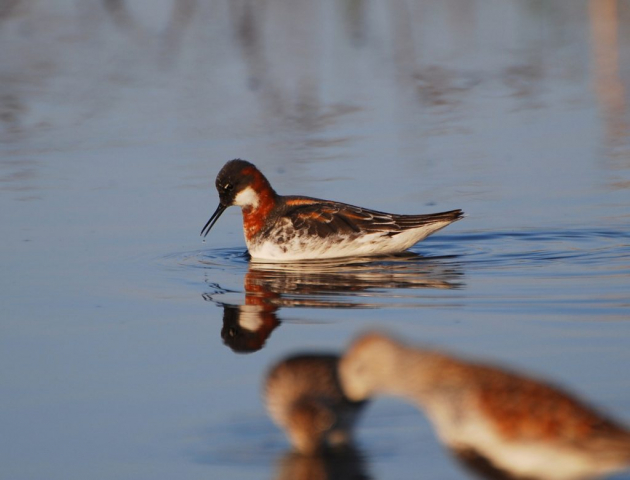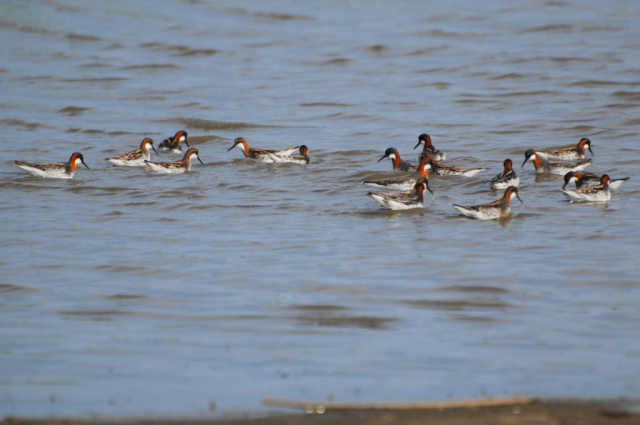Phalaropus lobatus
Status: Fairly common regular spring migrant west and central, uncommon east. Uncommon regular fall migrant west and central, rare east.

Documentation: Specimen: UNSM ZM6221, 23 Jun 1916 Mitchell, Scotts Bluff Co.
Taxonomy: No subspecies are recognized (AviList 2025).
Spring: Apr 27, 29, 29 <<<>>> Jun 1, 2, 3
An earlier date is 23 Apr 2008 Lincoln Co.
Later dates are 5 Jun 2024 between Oshkosh and Cresent Lake, Garden Co, 6 Jun 1908 Lancaster Co, 11 Jun 2024 (4) Crescent Lake NWR, Garden Co, 13 Jun 2025 (2) Smith Lake, Morrill Co (Tobin Brown), two males 19 Jun 2004 Lake McConaughy, Keith Co, 23 Jun 1916 alternate male (specimen cited above), two on 23 Jun 2004 Kiowa WMA, Scotts Bluff Co, and 28-30 Jun 1985 Sioux Co.
A relatively late migrant, the Red-necked Phalarope does not usually arrive until the second week of May and peak migration occurs during the third week. Around 75% of the reports fall within the short period 15-23 May. In 2024 however, there was an influx of early arrivals, with six reports earlier than previous early expected dates; 1-2 were at three Cherry Co locations 29 Apr-1 May, and 1-3 were at three Scotts Bluff Co locations 3 May.
There were only about 35 reports from the east until 2020, when a minor influx resulted in reports from eight locations of 12 birds 10-28 May. Only five were reported in the east in 2021, all singles at different locations, but in 2022 there was an amazing short-term influx in the east 19-24 May, when at least 146 were reported from 12 locations; best counts were 30 at Spikerush WMA, York Co 21 May, and 27 at both Tamora WMA, Seward Co 20 May and Straight Water WMA, Seward Co 20 May.
Reports after the first few days of Jun may be females, which leave breeding areas as soon as mid-Jun, and may be followed by failed breeders and males (O’Brien et al 2006) as well as individuals that discontinued spring migration.
- High counts: 460 in Sheridan Co 18 May 2004, 388 at Crescent Lake NWR, Garden Co 15 May 2006, 250 there 22 May 1997, and 245 at Goose Lake, Crescent Lake NWR 20 May 2025.
Fall: Aug 23, 23, 25 <<<>>> Oct 7, 8, 9
Earlier dates are 24 Jul 1979 Garden Co, 29 Jul 2010 Morrill Co, 3 Aug 2014 Garden Co, 5-13 Aug 2017 Seward Co, 7 Aug 2023 Lancaster Co, 9 Aug 2024 (2) Morrill Co, 10 Aug 2014 Lancaster Co, 20 Aug 2022 Lancaster Co, and 21-28 Aug 2015 Lancaster Co.
Later dates are 10 Oct 2010 Lancaster Co, 13 Oct 2019 Lancaster Co, 16 Oct 2016 Keith Co, 24 Oct 2015 a juvenile Harlan County Reservoir, Harlan Co, and 31 Oct 2002 Niobrara SL, Knox Co.
Reports prior to mid-Aug are few, presumably adults, while later reports beginning in late Aug are more numerous and widespread and are mostly, if not all, juveniles. In eastern and southern Nebraska juveniles are the most likely age to be encountered; three sight records in 1995 and two specimens, all in Sep, were juveniles. The five eastern Rainwater Basin records are of juveniles (Jorgensen 2012).
- High counts: 155 at Crescent Lake NWR 11 Sep 2021, 115 at Lake McConaughy 12 Sep 2022, 80 at Lake McConaughy 5 Sep 2021, and 45 in Sheridan Co 21 Sep 1996 (Grzybowski 1997).
Images
Abbreviations
NWR: National Wildlife Refuge
SL: Sewage Lagoons
UNSM: University of Nebraska State Museum
WMA: Wildlife Management Area (State)
Literature Cited
AviList Core Team, 2025. AviList: The Global Avian Checklist, v2025. https://doi.org/10.2173/avilist.v2025.
Grzybowski, J.A. 1997. Southern Great Plains Region. Field Notes 51: 78-82.
Jorgensen, J.G. 2012. Birds of the Rainwater Basin, Nebraska. Nebraska Game and Parks Commission, Lincoln, Nebraska, USA.
O’Brien, M., R. Crossley, and K. Karlson. 2006. The Shorebird Guide. Houghton Mifflin Co., New York, New York, USA.
Recommended Citation
Silcock, W.R., and J.G. Jorgensen. 2025. Red-necked Phalarope (Phalaropus lobatus). In Birds of Nebraska — Online. www.BirdsofNebraska.org
Birds of Nebraska – Online
Updated 22 Aug 2025


